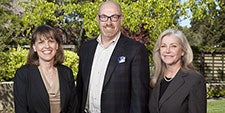High-Performing Legal Department Shows Its Mettle in Corporate Separation
By Jennifer J. Salopek
Three years ago, the Office of the General Counsel at Hewlett Packard began parallel initiatives, building capacity in the department while bringing more legal work in-house. In a corporate and departmental culture that celebrates collaboration and risk-taking, the effort to build bench strength and knowledge, aided by the savvy selection of best-in-class technology tools, flourished. As a result, the department was ready and capable of handling the largest corporate separation in history, yielding two Fortune 50 companies, Hewlett Packard, Inc., and Hewlett Packard Enterprise. It was completed on time, in slightly more than a year, under budget, and without significant interruption to the regular daily activities of the business.
Dianne Spindola, John Schultz, Molly Perry
“Since I became general counsel in 2012, we have been very focused on the view that the best legal resource is an in-house one,” says John Schultz, executive vice president, general counsel, and corporate secretary. “We are experts at what we do, and we try to rely on outside resources as the exception rather than the rule.”
The Office of the General Counsel (OGC) contributes income from licensing and sales of intellectual property and affirmative recovery programs. The total value from these programs over the past three years exceeded total spend, thus making the OGC a virtual profit center. At the same time, they pursued efficiency improvements, resulting in an average declined in total OGC spend of 5 percent over the past two years. Savings are strategically deployed: When litigation spend is below plan, the department redirects funding to the IP team to increase patent filings, which are up 24 percent over the past two years.
Although the separation wasn’t announced until October 2014, it is as though the OGC had been preparing for quite some time. Schultz and Molly Perry, chief operations officer for the department, had built a skilled internal team of 1,200, redesigned processes for efficiency, and equipped the team with leading technology tools that would make mountains of work manageable. Operations Manager Dianne Spindola brought discipline to data, making budgeting and forecasting so accurate—99.9 percent of budget—as to be nearly perfect.
“We looked for people who are capable of doing huge amounts of work and feel challenged and motivated by it. At the same time, we introduced a level of technology and innovation that allows people to be creative and adopt new tools,” Schultz says.
Once the split was announced, a corporate Separation Management Office was established to oversee the process, taking in five people from the OGC full-time, as well as representatives from every business area and unit. As activities were cascaded down through the organization, people were tasked with various parts of the work. The responsibilities of the legal department were focused on creating new entities, “cloning” country operations, moving cash and assets, assigning or “cloning” contracts, and allocating 50,000 patents and 15,000 trademarks. Although the separation touched everyone in the OGC, the core team numbered about 100.
Its members leveraged many of the technology tools already in use in the OGC, including:
- TeamConnect for matter management and e-billing
- Anaqua for IP management
- Salesforce.com for IP licensing and sales
- Autonomy for e-discovery
- Apttus for contract management
The OGC also implemented a project management tool, Midaxo, which is used to plan and monitor M&A transactions. Coupled with the department’s well-established discipline around project management, the tool was used effectively to manage the thousands of steps necessary to complete the separation.
To plan its own separation, the OGC implemented an online time-recording survey to determine the nature of work performed by OGC teams to provide a basis for staffing the two new legal teams. The tool was deployed in a matter of days and the results were used to determine the staffing models of the two new teams and their respective cost structures.
Perry notes that it was also necessary to clone all systems in order to complete the operational separation. That work involved roughly 80 applications and more than 300 SharePoint sites, with no business interruption.
“There was essentially no advance notice [of the separation] except for a very small team,” says Schultz. “The fact that we were already trying to get to the desired state for running a legal business—on our mission to become a more effective legal organization—facilitated our ability to do the separation.”
“Had we not laid the foundation, I don’t know how we could have achieved the separation the way we did,” says Perry.
